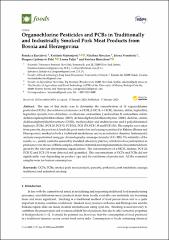Organochlorine Pesticides and PCBs in Traditionally and Industrially Smoked Pork Meat Products from Bosnia and Herzegovina

View/
Date
2020Author
Kartalović, Brankica
Mastanjević, Krešimir
Novakov, Nikolina
Vranešević, Jelena
Ljubojević Pelić, Dragana
Puljić, Leona
Habschied, Kristina
Metadata
Show full item recordAbstract
The aim of this study was to determine the concentration of 19 organochlorine
pesticides (OCPs): (hexachlorocyclohexane (α-HCH, β-HCH, δ–HCH), lindane, aldrin, heptachlor,
heptachlor epoxide, trans-chlordane, cis-chlordane, endosulfane I, endosulfane II, endosulfane sulfate,
dichlorodiphenyltrichloroethane (DDT), dichlorodiphenyldichloroethylene (DDE), dieldrin, endrin,
dichlorodiphenyldichloroethane (DDD), methoxychlor and endrin ketone and 6 polychlorinated
biphenyls (PCBs) (PCB 28, PCB 52, PCB 101, PCB 153, PCB 138 and PCB 180). The samples were taken
from pancetta, dry pork neck (budiola), pork tenderloin and sausages produced in Rakitno (Bosnia and
Herzegovina), smoked in both a traditional smokehouse and in an industrial chamber. Instrumental
analysis was performed using gas chromatography–mass spectrometry (GC–MS). The reliability of the
results, i.e., quality control is ensured by standard laboratory practice, which involves participation in
proficiency test, the use of blank samples, reference materials and implementation of recommendations
given by the relevant international organizations. The concentrations of α-HCH, lindane, PCB 28,
PCB 52 and PCB 153 were detected and quantified. The concentrations of OCPs and PCBs did not
significantly vary depending on product type and the conditions of production. All the examined
samples were for human consumption.
